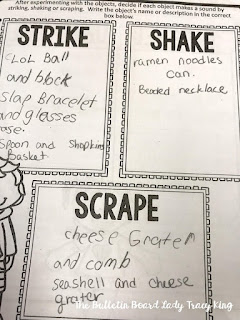Found Sounds Workshop has always been one of my favorite ways to teach about the science of sound. Actually, this magic little box is more than just a toy box. It is part of a larger, more comprehensive project that can end with instrument design and construction.
To begin, I collected many different items from around my classroom and home. I made sure these items would be safe to use in the classroom, made an interesting sound and were not valuable items. In considering safety I did not include forks, rubber bands or anything with a sharp, pointy edge. I didn't include anything valuable because kids break stuff.
I also purchased a few items from the dollar store because I wanted them to be new. For example, the scrub brush is a great addition to the Found Sounds Box, but a dirty one would not be fun! I also purchased a couple of cheese graters (that were not very sharp) and some gum in a plastic wrapped container. Every thing else was found at home or school.
I wanted to make sure that I included 4 types of items: shakers, strikers, scrapers and mallets.
Shakers: gum or candy containers in their plastic wrapping, cups of ramen noodles, Tic Tacs, a box of paper clips (that I taped closed) and keys on a key chain.
Scrapers: cheese graters, wire cups, beaded necklace, metal jar ring, scrub brush and combs.
Strikers: small lids from deodorant, spray paint, perfume bottles, etc..., tins and small boxes, miscellaneous containers, toys or pieces from toys and cups.
Mallets: pencils, pens, straws, chopsticks, etc...
Over the years, I've used several different kinds of boxes to store my found sound objects. Right now I'm using a small file folder box. Plastic shoe boxes are a great size to start with.
Activities
I most often use the Found Sounds Workshop as a workstation. Students can complete one activity in the time they have at this center. I have worksheets that ask students to categorize objects by how they make the best sound: strike, shake or scrape. Other worksheets as them to distinguish between pitch and unpitched, high and low and what material they are made of. Students love exploring the different objects in the box and often come up with some creative ideas for how to use them.
This activity works well with a variety of grade levels. With Kindergarten and 1st grade they often drew pictures of the objects than coming up with a name or description for them. My 4th and 5th graders were able to name (sometimes with great detail) the objects in the box.
After students have had an experience with classifying the objects in the box, the next activity is to create a composition and perform with their found sounds. I've experimented with this activity and discovered that it saves a great deal of time if I give them a framework that their composition can be created within. This includes a 16 block grid with room for writing/drawing their "instrument" choice. With some classes I chose to complete most of the grid for them so that they only have a few choices to make. This really is just a time saver, as students are able to complete the entire composition themselves. This ensures that everyone is ready for performance during the same class period.
The composition worksheets and all of the ones I've mentioned above are available for download HERE.
After students have completed the composition and have experience with what works best, it is time to create their own instrument by combining found objects. I've done this many different ways. If your school has a dedicated maker space, you may already have all of the raw materials that you will need. If not you'll want to send out requests to co-workers, parents and possibly some local factories for items your students can use for instrument construction. I have a large list of items that you can reproduce and send home with your students in the Found Sounds Workshop download in my TpT store.
One way to approach this project is to have students examine the materials that they have available to them and then sketch a design for an instrument. (I have them use a planning sheet during this part of the project.) Another way is to have them dream up a great idea, sketch it and make a list of needed supplies. Next, students find their supplies from your found sounds collections, recycle bins or from their homes. This way allows students the most creative experience but depending on students to bring in the needed supplies can cause problems.
In a small school district that I worked in, I had students complete their instruments at home and bring them in to class. This was mostly successful, but it was quite obvious which students did the work and which students' parents did the work.
If you are interested in using the worksheets that I use, they are available for download HERE.
If you like these ideas, PIN this post for later!





























